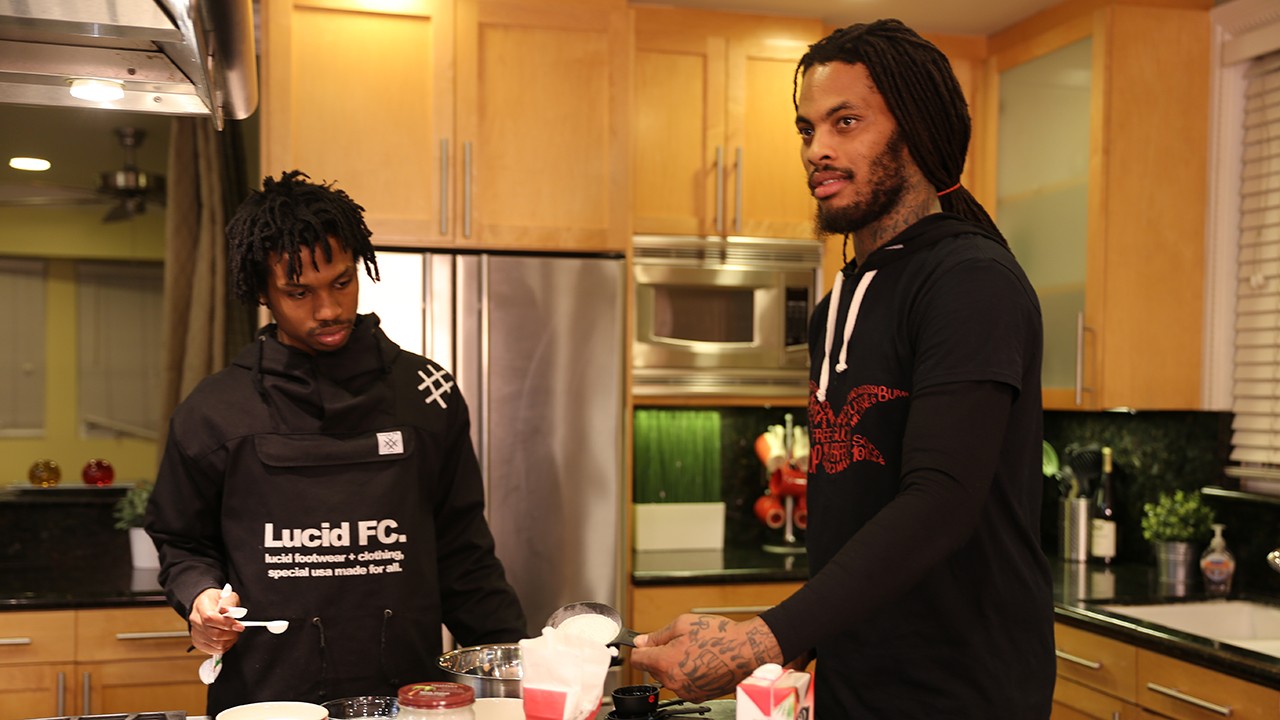In a whitewashed Manhattan loft space decorated with avocados, flickering candles, and pom-poms of pink peonies, Antoni Porowski sang the praises of Country Crock's "plant butter." Yes, that Country Crock—of the nondescript, gray-brown tubs that have sat in fridges nationwide for decades, full of "vegetable oil spread." And yes, that Antoni, the handsome, influential food guide of Netflix's Queer Eye.
Advertisement
What it boils down to, Porowski said, as he mixed ingredients for a "plant butter"-based bundt cake, is that dairy might be "weekend Antoni," but "weekday Antoni" leans away from milk products. As the plant-based space grows, legacy brands—both in animal products and their substitutes—are considering a change of pace, hence the term "plant butter," and hence Antoni.
All photographs by the author.
Butter alternatives, including and beyond Country Crock, grew in popularity over the 20th century, having found a following in many niches—from those looking to cut costs, to vegans, the health-conscious, the brand-loyal, and even the military. They serve a purpose. But when was the last time they seemed cool?With the current rise of "plant-based" branding, butter alternatives might just find new relevance. It's only fitting for this makeover to be paired with Porowski, not just for Country Crock, but also for the category. In addition to his boyish good looks and his Queer Eye manifesto that food can change lives, Porowski is also known for his love of yogurt-laced guacamole and Italian cheese; on any day, his endorsement of non-dairy butter is a smart strategy. In an America primed as the land of alt-milk and Impossible Burgers, perhaps it is time for alt-butter's comeuppance.
Butter alternatives, of which margarine might be the most notable, have long fought an image issue. That goes back to margarine's roots: in the mid-1800s, Napoleon tasked French scientists with creating a cheap butter alternative for the navy and the lower class, and margarine was born in 1869, when chemist Hippolyte Mège Mouriès turned beef fat and water into a thick cream, tinted it yellow with annatto, and patented the process. Margarine became a symbol of innovation and modernity.
Advertisement
Margarine made its way to the United States, where its manufacture worried the dairy industry—not unlike the concerns regarding alt-milks and meats today. By the 1880s, several states had issued margarine bans or regulations, and the Margarine Act of 1886 added federal taxation. In the early 20th century, several states prohibited margarine from being dyed yellow, so margarine was sometimes dyed pink, or the yellow dye was provided separately as a DIY getaround.Critics opposed margarine because it "challenged the 'butter mystique,'" wrote historian and professor Alysa Levene in a 2014 article on margarine, class, and modernity in the journal Contemporary British History. Butter's association with life, not to mention its "golden creaminess," made it more appealing than margarine in ideology. "People like to purchase an article which comes from the green pastures of the country, from the cows, rather than something which is made in a factory," a member of British Parliament once claimed in 1940, as Levene cited.
Margarine got a boost during the Great Depression and World War II, when scarcity and rationing prevented butter-buying. While butter meant "freedom and choice," margarine was associated with "privation and mean living," Levene wrote. "For many people it was shameful to serve margarine to guests or have it publicly known that one was a member of the 'margarine class.'" Still, by 1957, American consumption of butter and margarine were equal.
Advertisement
After that, with marketing campaigns selling margarine as the healthier option, spreads had a hold on the American market for the rest of the century, per numbers from the United States Department of Agriculture. In 2005, butter began its newest climb, in part because of a push toward "real" food and a renewed acceptance of fat. Margarine lost its dominance of the market, and things have been changing ever since. "Spreads are dead," Consumerist claimed in 2017.Despite its continued popularity, the oil-based stuff—with its humble, thrifty roots—has always had to fight for acceptance against butter's beloved image. So adored is butter that it's touted as the secret to basically everything. Restaurant-quality pasta? End with a knob of butter at the end. Better cookies? Salted butter. Creamier ramen? Butter, of course. What would Julia Child do? Probably add more butter, Jacqués Pepin once said.
Aside from image, the trick to making fake butter better might just be creating a closer facsimile of the real deal. At dinner with Antoni, everything on the menu is made with Country Crock Plant Butter. Spread thick on toast and softened as a dip for fresh summer radishes, it's convincing enough. "I love when you can take an American staple and change and adapt it based on what the needs of people are," Porowski said, standing behind the array of plant-butter-based plates. It won't fool anyone used to the truly artisanal, boutique-creamery stuff, but compared to what's at any old grocery store, it's not far off.
Advertisement
The brand's only certified dairy-free and vegan product, Plant Butter is the only product in the line that is both free from lactose and dairy, as well as "tested in production as dairy-free." Its ingredients list is longer but omits the vinegar in the original product, giving Plant Butter a milder, sweeter taste that's a little more like dairy butter.Meanwhile, the addition of avocado oil, almond oil, and olive oil will help Country Crock Plant Butter fetch a slightly higher price than the brand's original formula, or other buttery spreads on the market. "It's a little bit more premium cost than our regular Country Crock product, and the cost of the ingredients is higher. It sort of reflects that," Brian Orlando, chief marketing officer of Country Crock's parent company Upfield, told VICE. "It's basically in the market at a very similar price to private label butter."Country Crock's Plant Butter isn't the only product on the market that hopes to boost the reputation of these dairy-free substitutes. Fora Foods' FabaButter, made with the chickpea byproduct aquafaba, can brown and sauté like butter, which has earned it a positive review in the New York Times. "If I Close My Eyes, I’d Swear This European-Style Vegan Butter Is Real Butter," New York magazine declared regarding the cashew- and coconut-based cultured vegan butter from Miyoko's Creamery. Together, they're big upgrades to old vegan staples like Earth Balance, and budget-friendly spreads like the original I Can't Believe It's Not Butter!, which isn't as deceptive as its name would suggest.
Advertisement
For an entrenched brand, like Country Crock, the goal was "getting into a household that likes the taste profile of butter, but also wants an alternative," with a product that "cooks, tastes, and bakes like butter," Orlando told VICE. At Upfield, which describes itself as the leading global producer of plant-based spreads, Orlando oversees a portfolio of butter alternatives including Becel, Country Crock, I Can't Believe It's Not Butter!, Promise, and Brummel and Brown. "The vegan item in our I Can't Believe It's Not Butter! is the fastest-growing item in the range, so again, we know consumers are looking for this," Orlando said."I think our products historically, for the most part, have always been plant-based," Orlando said. That descriptor seems more useful now than it might have been for the company in the past, though its usage highlights the muddy waters of modern food labeling. What that means, looking at that range of products, is based in plant ingredients—like soybean oil, palm oil, and vegetable oil—but it hasn't always meant entirely plants: Becel, for example, is a blend of vegetable oils with buttermilk powder. Cynics could see "plant-based," in that case, as a way of keeping costs low, in the same way that processed foods like Oreos and Pillsbury Crescent Rolls are both "accidentally" vegan.Explaining that early margarine producers historically relied on a mix of ingredients, some animal-derived (whale oil and beef tallow, for example) and others not, Levene told VICE in an email, "To be honest, in the framework of the time I don't think that producers made too much of this, as it was useful for them to be able to change the composition of their product depending on price and availability."
Advertisement
The push for butter alternatives might have been pragmatic in the past, for reasons like cost and scarcity, but now, the arguments for fake butter are coming from all sides. In a world acknowledging and reckoning with climate change, the push to cut down consumption of animal-based products is loud. Wellness, of course, is the word of the post-Goop era, spurring an interest in a slew of new diets like Atkins, raw, Mark Bittman's VB6, and even eating like Beyoncé. Entrepreneurs, emboldened by the success of tech meat and alt-milk, seek to reinvent—or at least rebrand—every possible wheel in the food space. Consumer curiosity has probably helped, too.As for those arguments about margarine being synthetic, even shameful? For some people, the growing list of alt-butter's benefits have been gaining more traction, and an increasingly wider market may be willing to give it a shot. As younger people increase their buying power, the market might continue to change. "I will be interested to see whether the newer and growing attention to intensive farming and sustainability effects further change, especially since I suspect that the butter mystique is particularly a factor for older generations," Levene said.Add the word "avocado" and pair it with Antoni, and the transition away from butter might be smoother still. As he finished mixing his cake, Antoni added, "Traditions are meant to be broken sometimes."Sign up for our newsletter to get the best of VICE delivered to your inbox daily.Follow Bettina Makalintal on Twitter.

